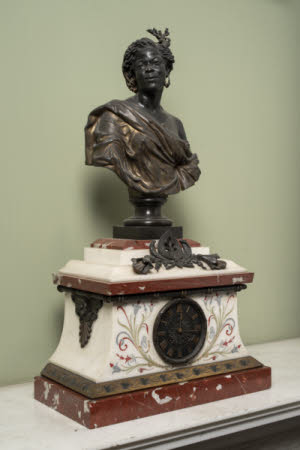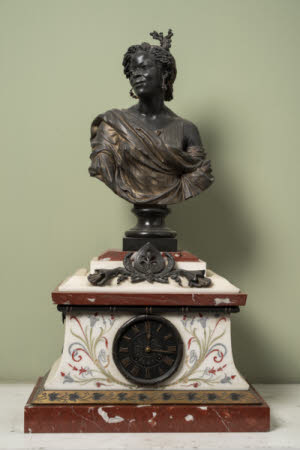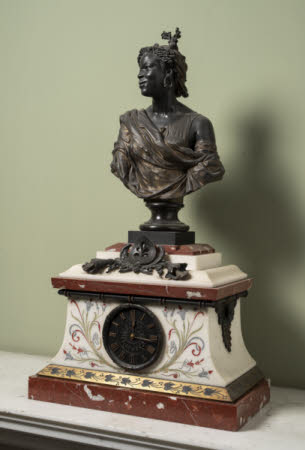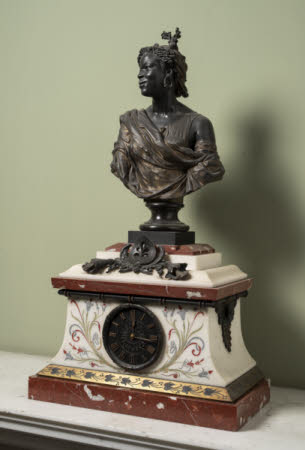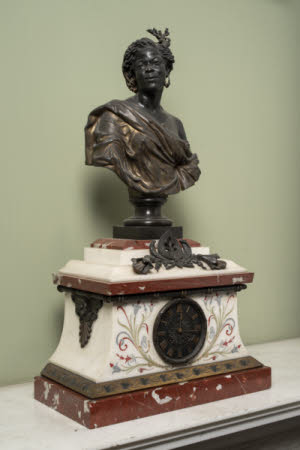Femme des Colonies
Lerolle Frères
Category
Horology
Date
1861
Materials
Bronze and gilt bronze, marble
Measurements
780 mm (Height)
Place of origin
Paris
Order this imageCollection
Ickworth, Suffolk
NT 850800
Summary
Bronze, brass, red and white marble, 'Femme des colonies', after the model by Charles Henri Joseph Cordier (Cambrai 1827 – Algiers 1905), 1861, cast by Lerolle Frères, Paris, inscribed on the hem of the drapery at proper left ‘CORDIER 1861’, mounted on a marble pedestal inlaid with bronze clock dial. A patinated bronze bust of a woman, turned to proper right, wearing a loose shift and drapery hung over the proper right shoulder, with jewelled arm band on proper left upper arm, a headwrap tied with flowers and beaded hoop earrings. Cast from a reduction model of Charles Cordier’s 'Femmes des colonies' in patinated bronze and onyx, 1861 (Musée d'Orsay RF 2996, LUX 28). Mounted on a bronze socle, black marble base and a pedestal of red and white marble, with a bronze anthemion ornament. The whole mounted on a painted marble, bronze and gilt bronze pedestal inlaid with a bronze clock dial signed in gilt 'LEROLLE' under the numeral XII and 'PARIS' above VI. The movement: stamped on the back of the back plate, top left, 'LEROLLE PARIS 289'; stamped under centre arbor potence 'P.Ltre'; above bottom pillar a circular medal stamp 'MEDAILLE D'ARGENT 1855 & Cie' (Vincenti & Cie); left of bottom pillar '5' and right of bottom pillar '8'; on front of the front plate 'R'; suspension spring of the Brocot type; stamped on top of the Brocot 17 tooth wheel 'Brocot propte'.
Full description
Charles Cordier was a French Orientalist sculptor specialising in busts of North African peoples. Cordier undertook various research missions to the French colony of Algeria (1856), Greece (1858), and the Khedivate of Egypt (1866, 1868) with the purpose of studying ethnic or cultural ‘types’ within those regions. Cordier is particularly recognised for reviving polychrome sculpture, and for his use of imported coloured marbles and experimental patination, plating and enamelling techniques. His debut work, a painted plaster bust of the formerly enslaved Sudanese man Seïd Enkess (b. 1807), was entered into the Paris Salon of 1848 under the title Saïd Abdullah of the Mayac, Kingdom of the Darfur. Brought to Paris enslaved, Enkess began working as a professional model after the abolition of slavery in France and its colonies in 1848. He was much sought-after in ethnographic circles having been cast from life by the Ethnological Society, Paris, in 1847. The bust was re-submitted in bronze two years later with a pendant portrait of a freed woman from Guadeloupe entitled the African Venus. Casts by Simonet were shown at the Great Exhibition of 1851 and later purchased by Queen Victoria in 1852 (Royal Collection Trust, RCIN 41510), elevating the profile of Cordier’s work in Britain. In July 1860 Cordier exhibited 49 ethnographic busts at the Palais de l’industrie, Paris, a collection based on studies done from life during his time in Algeria. Napoleon III purchased two busts, and a year later Femme des Colonies, after which the present reduced version is modelled. Known by the alternative title Câpresse des Colonies, the bust is supposed to depict a woman of mixed black and white heritage from the French Antilles, modelled from life. Femme des Colonies and its pendant Nègre du Soudan were shown to acclaim at the International Exhibition, London, in 1862. Fifteen of the busts exhibited at the Palais de l’industrie were reproduced for the anthropological galleries of the Muséum d'Histoire Naturelle. Cordier said that his work was ‘fundamentally artistic and scientific’, underpinned by empirical observation of ‘various types of indigenous peoples’, ‘from the standpoint of art’ (Cordier quoted in Margerie et Papet 2005, pp. 133, 131). Cordier’s method, in his words, was to ‘study the form of [the subject’s] head, the expression of their physiognomy’ and the ‘common characteristics of the race that I wish to represent’ (Cordier 1862, p. 66). ‘I appreciate them [the subject] as a whole’, he continued, ‘as well as in their details’, these unique physiognomic traits subtly altered to arrive at ‘an ideal type’, ‘or rather the ideal type of their characteristics’ (ibid). Cordier had 19 of his busts photographed in 1857, categorising them according to Eurocentric hierarchies. The present bust was cast by the Parisian bronze foundry Lerolle Frères which specialised in antiquarian and Louis XIII-XIV fine art castings and garniture. In 1878 Lerolle Frères exhibited bronzes after earlier models by Cordier at the Exposition Universelle, Paris.
Provenance
Part of the Bristol Collection. Acquired by the National Trust in 1956 under the auspices of the National Land Fund, later the National Heritage Memorial Fund
Marks and inscriptions
On the hem of the drapery, proper left : CORDIER 1861
Makers and roles
Lerolle Frères, founder Charles-Henri-Joseph Cordier (1827 - 1905), sculptor
References
Larson 2005: Barbara Larson, 'The Artist as Ethnographer: Charles Cordier and Race in Mid-Nineteenth Century France', The Art Bulletin, December 2005, vol. 87, no. 4, pp. 714-72 Margerie and Papet 2004: Laure de Margerie and Edouard Papet, with contributions by Christine Barthe and Maria Vigli, Facing the Other: Charles Cordier (1827 1905); Ethnographic Sculptor, exh. cat. New York 2004 Cordier 1862: Charles Cordier, 'Rapport de Charles Cordier: Types ethniques representés par la sculpture', Bulletin de la Société d'Anthropologie de Paris, 1862
